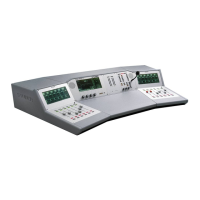OnAir 2000M2 Digital Mixing Console
1-4 Intro SW V 4.0 Date printed: 12.11.03
1.2 Definition of Terms
Terms used in this manual:
Input: The physical input connector of the input module; standard input modules
have two selectable (mono or stereo) inputs, while the hex line input mod-
ules have six selectable stereo inputs.
These inputs are equipped either with 3-pin XLR connectors or, for the
hex input modules, with 39-pin Siemens connectors.
On Digital Input Modules, there is a selection of two AES/EBU inputs on
XLR connectors and two S/PDIF inputs on Cinch connectors and on opti-
cal (TOSlink) connectors available.
Input Module: Hardware module, containing two (or six) mono or stereo inputs.
Microphone Input Modules have two transformer-balanced mono inputs on
XLRs with selectable 48 V phantom supply.
Analog Line Input Modules have two stereo inputs on XLRs, they are
available with electronically or transformer-balanced input configuration.
On Digital Line Input Modules, there is a selection of two AES/EBU in-
puts on XLR connectors and two S/PDIF inputs with Cinch and optical
(TOSlink) connectors available.
Analog Hex Line Input Modules have six stereo inputs on 39-pin Siemens
connectors, while the Digital Hex Input Modules have six AES/EBU in-
puts on 39-pin Siemens connectors as well.
Each input of an input module is equipped with control inputs and outputs
(GPIO) used for fader start, mute, signaling, etc.; these control inputs and
outputs are available on D-type connectors.
Channel: A channel is the combination of all signal processing functions that can be
assigned to a fader strip, as A/B (or one-out-of-six) input selection, gain,
filter, EQ, pan/balance etc.; each channel can be routed to any fader strip
thanks to the channel routing performed in the DSP section of the console.
Fader Strip: A fader strip contains the operating elements of a channel, as linear fader,
ON, OFF, and PFL key, as well as a section of the channel touch screen
next to the hardware operating elements.
As the number of operating elements is reduced to a minimum, the adjust-
ment of some less often used channel functions, as e.g. EQ setting, is per-
formed on the center touch screen and the rotary encoders located next to
this screen.

